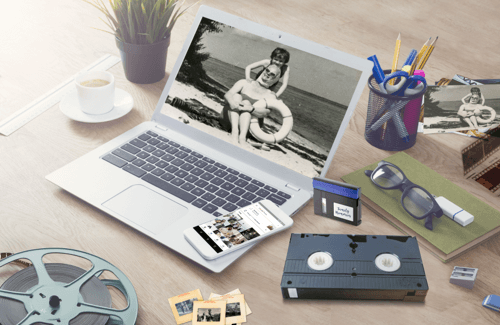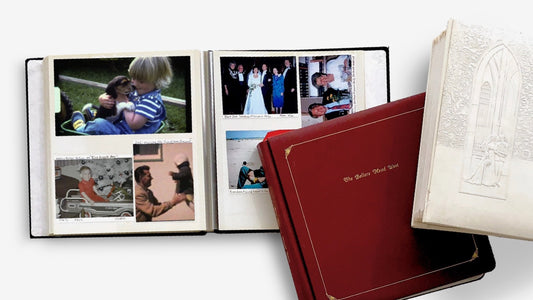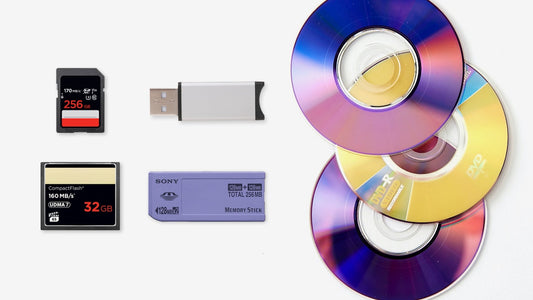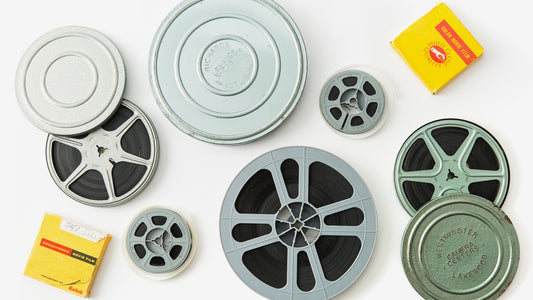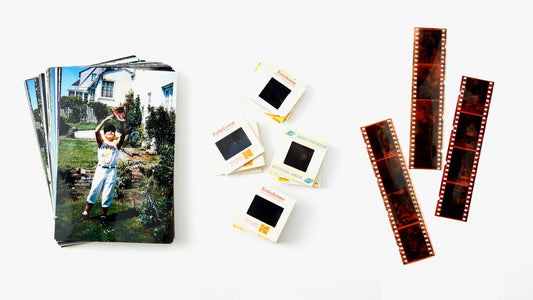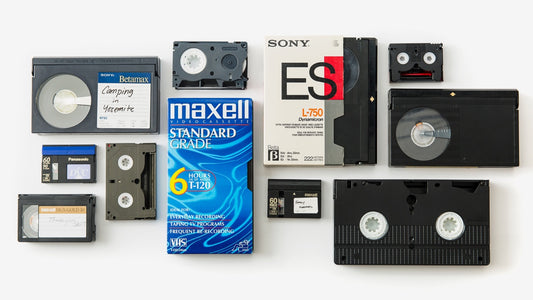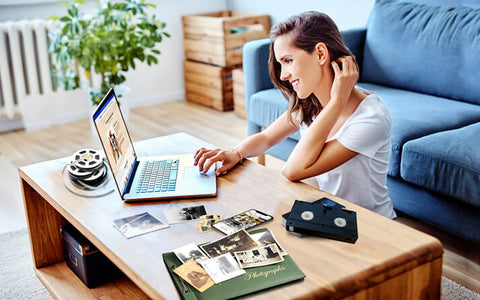Your wedding day, your child's first steps, that unforgettable family vacation—precious moments captured on VHS tapes, now gathering dust on a shelf. But what happens when your VCR finally gives out? Those memories become inaccessible, trapped on obsolete technology. Transferring VHS to DVD is the key to unlocking those moments, ensuring they remain vibrant and accessible for generations to come. This guide will delve into the importance of digitizing your home movies, the various options available for VHS to DVD transfer, and the factors to consider when choosing the right path. We'll explore the pros and cons of professional services versus DIY methods, empowering you to make an informed decision that safeguards your family's legacy.
Key Takeaways
- Safeguard your memories: VHS tapes deteriorate over time. Transferring them to DVD or digital formats protects your precious home movies from damage and loss. Professional services like YesVideo offer expertise and convenience, especially for irreplaceable recordings.
- Select the best transfer approach: DIY is budget-friendly but requires technical know-how and a time investment. Professional services are convenient and often yield higher quality, but they come with a price tag. Balance your priorities—time, budget, and quality—to determine the right path for you.
- Focus on quality from start to finish: Regardless of whether you choose DIY or professional services, take steps to maximize the quality of your transfers. Clean your tapes and equipment, monitor the process, and consider editing your digitized videos afterward for enhancements. Professional services are often the best choice for valuable or fragile tapes.
What is VHS to DVD Transfer?
What is VHS to DVD Transfer?
Digitizing Analog Video
Remember those bulky VHS tapes stacked in your closet? They hold precious memories: birthday parties, graduations, family vacations. VHS to DVD transfer is how you convert those old analog recordings into a digital format you can easily watch today. It's like giving your home movies new life, transforming them from fuzzy VHS tapes to crisp, clear digital files. This process is also known as digitizing analog video. You're essentially creating a digital copy of your old tapes, making them viewable on modern devices like DVD players, computers, and even smartphones. YesVideo offers several options for transferring your treasured memories to digital formats, ensuring your family history stays vibrant and accessible. Digitizing your videos is more than just changing the format; it's preserving those memories for future generations. Analog tapes degrade over time, losing picture quality and even becoming unplayable.
Let's be honest, those VHS tapes stacked in your closet aren't getting any younger. Transferring them to DVD isn't just about updating the format; it's about safeguarding your memories. Here's why making the switch is so important:
Preserve Precious Memories
Why Transfer VHS Tapes to DVD?
Let's be honest, those VHS tapes stacked in your closet aren't getting any younger. Transferring them to DVD isn't just about updating the format; it's about safeguarding your memories. Here's why making the switch is so important:
Preserve Precious Memories
Time takes its toll on everything, and VHS tapes are no exception. They degrade over time, losing picture and sound quality. Transferring your VHS tapes to DVD creates a digital copy of your memories, protecting them from the inevitable wear and tear of aging magnetic tape. Think of it as future-proofing those precious moments, ensuring they remain vivid for years to come. This way, you can share those first steps, graduations, and family vacations with generations to come, exactly as you remember them. YesVideo offers services to help preserve these precious memories.
Improve Accessibility and Playback
Remember the last time you tried to watch a home movie? Digging out the old VCR, hoping it still works, and then dealing with tangled tapes can be a real hassle. Digitizing your videos makes them instantly accessible. You can pop a DVD into any standard player or easily transfer the files to your computer for editing and sharing. Plus, let's face it, VCRs are becoming relics of the past. Transferring to DVD ensures you can actually watch those memories without needing to hunt down a working VCR. For a simpler approach, explore VHS conversion services.
Save Space
We've all got that box (or boxes!) of VHS tapes taking up precious storage space. Converting them to digital files, whether on DVD or another format, frees up that physical space. You can reclaim that corner of your closet or shelf without losing the memories stored on those bulky tapes. Plus, digital storage is much more compact and easier to organize. You can easily label and categorize your digital files, making it a breeze to find the exact moment you're looking for. Consider [digitizing your VHS tapes] to save space and declutter your home.
YesVideo stands out for its comprehensive approach. They offer video transfer services that include access to MemoryCloud, their digital storage platform. This allows you to get your memories on DVD and view, download, and share them online, even directly to platforms like Google Photos. This combination of physical media and digital access makes it a convenient option for preserving and enjoying your old home movies.
Legacybox
Legacybox provides a similar service, converting VHS tapes, film reels, and photos to digital formats. You can choose to receive your digitized memories on DVDs, thumb drives, or in cloud storage. This flexibility lets you select the format that best suits your needs.
Walmart Photo Center
For a budget-friendly option, you can check out Walmart’s VHS to DVD conversion service. Their pricing structure is based on the length of your tapes, making it easy to estimate the cost.
Costco Photo Center
While Costco is known for its photo services, it's worth noting that their home video and photo transfer services have some limitations. They don't currently offer negative or digital media transfers, so if you have those types of media, you'll need to look elsewhere.
CVS Photo
CVS offers a variety of photo services, and select locations also provide VHS to DVD transfer. Check with your local CVS to see if this service is available in your area.
iMemories
iMemories offers a wide range of digital output options, including DVD, Blu-ray, portable hard drives, flash drives, and cloud storage. This gives you a lot of choices for how you want to receive and access your digitized videos. For a comparison of iMemories, YesVideo, and Costco, check out this review to see which best fits your needs.
Southtree
Southtree focuses on a streamlined process for VHS to digital conversion, prioritizing quality and customer service. If a smooth and reliable experience is important to you, Southtree might be a good fit.
EverPresent
EverPresent specializes in digitizing family memories, including VHS tapes. They emphasize high-quality transfers and customer satisfaction. If preserving the best possible quality of your memories is your top priority, you might consider their services.
Want to digitize your VHS tapes yourself? It's definitely doable, though it requires a bit of effort and the right equipment. This section walks you through the process.
Essential Equipment for Home Transfers
First, gather your tools. You'll need a working VCR to play your tapes and a DVD recorder to capture the video. A combo unit with both a VCR and DVD recorder simplifies the setup. You can typically find these on online marketplaces like eBay or even at thrift stores. Of course, you'll also need a supply of blank DVD-R discs. For those wanting more control, a VCR-to-USB adapter paired with video editing software on your computer offers a more advanced approach. This setup lets you clean up the video and make edits before burning it to a DVD.
Step-by-Step Guide to DIY Transfers
Once you have your equipment, the transfer process is fairly straightforward. Start by connecting your VCR to your DVD recorder. Insert your VHS tape into the VCR and a blank DVD-R into the DVD recorder. Double-check that your DVD recorder is set to record from the VCR input. Then, press play on the VCR and the record button on the DVD recorder simultaneously. It's a good idea to monitor the recording to catch any glitches. After the tape has finished playing, finalize the DVD in the recorder. This step is crucial for making the DVD playable on other DVD players. For a more detailed guide, check out this article on converting VHS home movies.
Software Options for Digital Conversion
If you're comfortable using computer software, you have more options for converting and editing your videos. A VCR-to-USB adapter allows you to capture the video on your computer. From there, you can use software like Wondershare UniConverter to burn the video to a DVD. Using video editing software gives you even greater control. You can enhance the video quality, add titles, and create chapters. Consider this resource on common problems converting VHS to digital for a smoother experience.
Costs and Considerations
Digitizing your home movies is an investment in preserving memories. So, let’s break down the costs and considerations for both professional services and DIY methods. Understanding the pricing structures and potential expenses will help you make the best choice for your needs and budget.
Professional Service Pricing
Professional services offer convenience and expertise. Pricing typically depends on factors like the length of your videotapes and the number of copies you need. Services like Walmart offer VHS to DVD conversion starting at $15.96 for the first 30 minutes of video, then $7.46 for each additional 30 minutes. DVDs are an extra $3.96 per disc if ordered with the transfer, or $9.96 if ordered within 60 days. Walmart's video transfer services page has the latest details. Legacybox is another popular choice, charging between $9 to $15 per tape depending on the quantity, with a special offer of $9 per tape for orders of 10 or more. Check their site for current Legacybox pricing. YesVideo provides services through retailers like Costco, CVS, Walmart, and Target, typically for around $25 per tape. You can explore YesVideo's video transfer options on their website.
DIY Method Expenses
If you’re technically inclined and want to save money, transferring VHS tapes yourself is possible. You'll need a DVD recorder/VHS VCR combo player. This lets you transfer tapes by inserting a VHS tape and a blank DVD-R, then pressing record. A used VHS/DVD player might cost around $250 or more, according to this PCMag article on converting home movies. Factor in the cost of blank DVDs, too.
Potential Hidden Fees
With professional services, be mindful of potential hidden fees. Some services charge extra for things like adding music or titles. Walmart, for example, has additional costs like $5.46 for each extra 30 minutes of video and $0.45 per additional photo, slide, or negative. Carefully review the pricing details before committing to a service, especially regarding added costs for USB and DVD outputs. Don't forget to consider the cost of shipping your tapes.
Transfer VHS to DVD Yourself: Equipment and Process
Want to digitize your VHS tapes yourself? It's definitely doable, though it requires a bit of effort and the right equipment. This section walks you through the process.
Essential Equipment for Home Transfers
First, gather your tools. You'll need a working VCR to play your tapes and a DVD recorder to capture the video. A combo unit with both a VCR and DVD recorder simplifies the setup. You can typically find these on online marketplaces like eBay or even at thrift stores. Of course, you'll also need a supply of blank DVD-R discs. For those wanting more control, a VCR-to-USB adapter paired with video editing software on your computer offers a more advanced approach. This setup lets you clean up the video and make edits before burning it to a DVD.
Step-by-Step Guide to DIY Transfers
Once you have your equipment, the transfer process is fairly straightforward. Start by connecting your VCR to your DVD recorder. Insert your VHS tape into the VCR and a blank DVD-R into the DVD recorder. Double-check that your DVD recorder is set to record from the VCR input. Then, press play on the VCR and the record button on the DVD recorder simultaneously. It's a good idea to monitor the recording to catch any glitches. After the tape has finished playing, finalize the DVD in the recorder. This step is crucial for making the DVD playable on other DVD players. For a more detailed guide, check out this article on converting VHS home movies.
Software Options for Digital Conversion
If you're comfortable using computer software, you have more options for converting and editing your videos. A VCR-to-USB adapter allows you to capture the video on your computer. From there, you can use software like Wondershare UniConverter to burn the video to a DVD. Using video editing software gives you even greater control. You can enhance the video quality, add titles, and create chapters. Consider this resource on common problems converting VHS to digital for a smoother experience.
Common Mistakes and How to Avoid Them
Transferring VHS tapes to DVD is more than just hitting "record." While the concept is simple, several common mistakes can compromise the quality of your digitized memories. Let's explore some of these pitfalls and how to avoid them, ensuring your precious moments are preserved beautifully.
Equipment-Related Errors
The right equipment is essential for successful VHS to DVD transfers. One frequent mistake is neglecting to clean your VHS tapes and playback equipment. Dust and debris interfere with playback and recording, leading to a less-than-ideal final product. A simple cleaning with a head cleaner can dramatically improve your transfer quality. The type of VCR you use also matters. A high-quality VCR with stable playback capabilities will produce far better results than a worn-out machine. If your VCR is on its last leg, consider borrowing or renting a model in better condition.
Process Pitfalls
Even with good equipment, procedural missteps can impact the quality of your transfer. Incorrect tracking settings on your VCR are a common culprit. If the tracking is off, the picture can appear distorted or unstable. Check your VCR's manual for instructions on adjusting the tracking. Another potential issue is the connection between your VCR and DVD recorder. Securely connect the cables and double-check the input and output settings on both devices. A loose connection can lead to signal loss and an incomplete transfer.
Quality Control Oversights
Finally, don't skimp on quality control. The condition of your original VHS tapes significantly impacts the final product. Older or damaged tapes are prone to color degradation, flickering, and tracking problems. While some deterioration is inevitable, handling your tapes carefully and storing them correctly can minimize these issues. After the transfer, review the DVD. If you spot any significant problems, you might need to repeat the process, adjusting settings or trying different equipment. Since the goal is a lasting digital copy, aim for the best possible quality. Consider using a professional service like YesVideo for valuable or delicate tapes to ensure the best possible outcome.
Best Practices for Successful VHS to DVD Transfers
Transferring your VHS tapes to DVD is a smart move to protect those precious memories. Whether you're doing it yourself or using a professional service, following some best practices can significantly impact the final quality.
Prepare Your Tapes and Equipment
Before starting the transfer, prepare your VHS tapes. Rewinding them to the beginning prevents accidental recording over existing footage. Inspect the tapes for any signs of mold or damage. If you find any issues, a professional service like YesVideo has the expertise and equipment to handle these situations. For DIY transfers, ensure your VCR and DVD recorder are clean and functioning correctly, as dust and debris can affect playback and recording quality. Simple maintenance can improve your video transfer results.
Common Mistakes and How to Avoid Them
Transferring VHS tapes to DVD is more than just hitting "record." While the concept is simple, several common mistakes can compromise the quality of your digitized memories. Let's explore some of these pitfalls and how to avoid them, ensuring your precious moments are preserved beautifully.
Equipment-Related Errors
The right equipment is essential for successful VHS to DVD transfers. One frequent mistake is neglecting to clean your VHS tapes and playback equipment. Dust and debris interfere with playback and recording, leading to a less-than-ideal final product. A simple cleaning with a head cleaner can dramatically improve your transfer quality. The type of VCR you use also matters. A high-quality VCR with stable playback capabilities will produce far better results than a worn-out machine. If your VCR is on its last leg, consider borrowing or renting a model in better condition.
Process Pitfalls
Even with good equipment, procedural missteps can impact the quality of your transfer. Incorrect tracking settings on your VCR are a common culprit. If the tracking is off, the picture can appear distorted or unstable. Check your VCR's manual for instructions on adjusting the tracking. Another potential issue is the connection between your VCR and DVD recorder. Securely connect the cables and double-check the input and output settings on both devices. A loose connection can lead to signal loss and an incomplete transfer.
Quality Control Oversights
Finally, don't skimp on quality control. The condition of your original VHS tapes significantly impacts the final product. Older or damaged tapes are prone to color degradation, flickering, and tracking problems. While some deterioration is inevitable, handling your tapes carefully and storing them correctly can minimize these issues. After the transfer, review the DVD. If you spot any significant problems, you might need to repeat the process, adjusting settings or trying different equipment. Since the goal is a lasting digital copy, aim for the best possible quality. Consider using a professional service like YesVideo for valuable or delicate tapes to ensure the best possible outcome.
If you're on a tight budget and comfortable with technology, transferring VHS tapes yourself with a DVD recorder and VCR is a solid option. You'll need to invest in the equipment, but the per-tape cost goes down significantly after that initial purchase. This method gives you more control, but it does require some technical skills. For maximum control and the ability to edit your videos, connecting your VCR to your PC offers the most flexibility. However, this is the most technically challenging DIY method.
Make an Informed Decision
Transferring your VHS tapes to DVDs ensures your memories are preserved in a format you can actually watch. DVDs are compatible with most DVD players, and you can easily transfer the digital files to your computer for editing and sharing. YesVideo specializes in these kinds of transfers, focusing on quality and providing a digital copy of your transferred videos.
Remember, the quality of the DVD will depend on the condition of your original VHS tape. A professional service won't be able to magically fix a badly damaged tape, but they can often get the best possible result. Consider what's most important to you—saving time, maximizing quality, or minimizing cost—and choose the method that best fits your needs.
Best Practices for Successful VHS to DVD Transfers
Transferring your VHS tapes to DVD is a smart move to protect those precious memories. Whether you're doing it yourself or using a professional service, following some best practices can significantly impact the final quality.
Prepare Your Tapes and Equipment
Before starting the transfer, prepare your VHS tapes. Rewinding them to the beginning prevents accidental recording over existing footage. Inspect the tapes for any signs of mold or damage. If you find any issues, a professional service like YesVideo has the expertise and equipment to handle these situations. For DIY transfers, ensure your VCR and DVD recorder are clean and functioning correctly, as dust and debris can affect playback and recording quality. Simple maintenance can improve your video transfer results.
Monitor the Transfer Process
Keep a close eye on the transfer process. If using a VCR, periodically check the tracking settings. Adjusting the tracking can significantly improve the video quality, minimizing static and distortion. For those choosing a professional service, ask about their quality control process. Understanding how they handle potential issues during the transfer offers valuable reassurance. Converting VHS tapes to DVD can be a delicate process, so monitoring is key.
Edit and Enhance Post-Transfer
After transferring your VHS tapes to DVD, you have options for enhancing the final product. Basic video editing software allows you to trim unwanted footage, add titles, and stabilize shaky video. You can often correct audio-video sync issues with video editing software. Remember, some imperfections might remain, especially with older or damaged tapes, even with the best equipment and techniques. Consider these imperfections part of your home movies' unique charm and history. Troubleshooting common issues can further improve the quality of your digitized memories.
Is it better to transfer my VHS tapes myself or use a professional service? It depends on your priorities. DIY is more hands-on and potentially less expensive initially, but it requires technical know-how and a time investment. Professional services offer convenience and expertise, often with better quality control, but come with a per-tape cost.
What are the key things to consider when choosing a professional transfer service? Look at their pricing structure, the types of formats they handle, and what kind of digital copies they provide. Some services offer cloud storage or downloadable files in addition to DVDs. Also, check reviews to see what other customers say about their experience.
What are some common mistakes to avoid when transferring VHS tapes to DVD? Whether you're doing it yourself or using a service, ensure your tapes and equipment are clean. For DIY transfers, pay close attention to the tracking settings on your VCR and the connections between your devices. With a professional service, ask about their quality control process to ensure your memories are handled with care.




